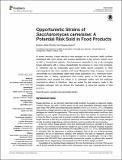Por favor, use este identificador para citar o enlazar a este item:
http://hdl.handle.net/10261/152918COMPARTIR / EXPORTAR:
 SHARE SHARE
 CORE
BASE CORE
BASE
|
|
| Visualizar otros formatos: MARC | Dublin Core | RDF | ORE | MODS | METS | DIDL | DATACITE | |

| Campo DC | Valor | Lengua/Idioma |
|---|---|---|
| dc.contributor.author | Pérez-Torrado, Roberto | - |
| dc.contributor.author | Querol, Amparo | - |
| dc.date.accessioned | 2017-07-14T11:26:37Z | - |
| dc.date.available | 2017-07-14T11:26:37Z | - |
| dc.date.issued | 2016-01-08 | - |
| dc.identifier.citation | Frontiers in Microbiology 6: 1522 (2016) | - |
| dc.identifier.issn | 1664-302X | - |
| dc.identifier.uri | http://hdl.handle.net/10261/152918 | - |
| dc.description.abstract | In recent decades, fungal infections have emerged as an important health problem associated with more people who present deficiencies in the immune system, such as HIV or transplanted patients. Saccharomyces cerevisiae is one of the emerging fungal pathogens with a unique characteristic: its presence in many food products. S. cerevisiae has an impeccably good food safety record compared to other microorganisms like virus, bacteria and some filamentous fungi. However, humans unknowingly and inadvertently ingest large viable populations of S. cerevisiae (home-brewed beer or dietary supplements that contain yeast). In the last few years, researchers have studied the nature of S. cerevisiae strains and the molecular mechanisms related to infections. Here we review the last advance made in this emerging pathogen and we discuss the implication of using this species in food products. | - |
| dc.description.sponsorship | RP-T was supported by CICYT grants (ref. AGL2012-39937-CO2-01 and -02) from the Spanish Ministry of Education and Science and FEDER. This work was supported by grant PROMETEO (project PROMETEO/2009/019) from the Generalitat Valenciana. | - |
| dc.publisher | Frontiers Media | - |
| dc.relation.isversionof | Publisher's version | - |
| dc.rights | openAccess | - |
| dc.title | Opportunistic Strains of Saccharomyces cerevisiae: A Potential Risk Sold in Food Products | - |
| dc.type | artículo | - |
| dc.identifier.doi | 10.3389/fmicb.2015.01522 | - |
| dc.description.peerreviewed | Peer reviewed | - |
| dc.relation.publisherversion | http://dx.doi.org/10.3389/fmicb.2015.01522 | - |
| dc.date.updated | 2017-07-14T11:26:37Z | - |
| dc.description.version | Peer Reviewed | - |
| dc.language.rfc3066 | en | - |
| dc.rights.holder | Copyright © 2016 Pérez-Torrado and Querol. | - |
| dc.rights.license | http://creativecommons.org/licenses/by/4.0/ | - |
| dc.contributor.funder | Ministerio de Educación y Ciencia (España) | - |
| dc.contributor.funder | European Commission | - |
| dc.contributor.funder | Generalitat Valenciana | - |
| dc.relation.csic | Sí | - |
| dc.identifier.funder | http://dx.doi.org/10.13039/501100003359 | es_ES |
| dc.identifier.funder | http://dx.doi.org/10.13039/501100000780 | es_ES |
| dc.identifier.pmid | 26779173 | - |
| dc.type.coar | http://purl.org/coar/resource_type/c_6501 | es_ES |
| item.openairetype | artículo | - |
| item.grantfulltext | open | - |
| item.cerifentitytype | Publications | - |
| item.openairecristype | http://purl.org/coar/resource_type/c_18cf | - |
| item.fulltext | With Fulltext | - |
| Aparece en las colecciones: | (IATA) Artículos | |
Ficheros en este ítem:
| Fichero | Descripción | Tamaño | Formato | |
|---|---|---|---|---|
| Opportunistic Strains of Saccharomyces cerevisiae.pdf | 434,02 kB | Adobe PDF |  Visualizar/Abrir |
CORE Recommender
PubMed Central
Citations
33
checked on 23-abr-2024
SCOPUSTM
Citations
61
checked on 19-abr-2024
WEB OF SCIENCETM
Citations
27
checked on 23-feb-2024
Page view(s)
235
checked on 23-abr-2024
Download(s)
250
checked on 23-abr-2024

